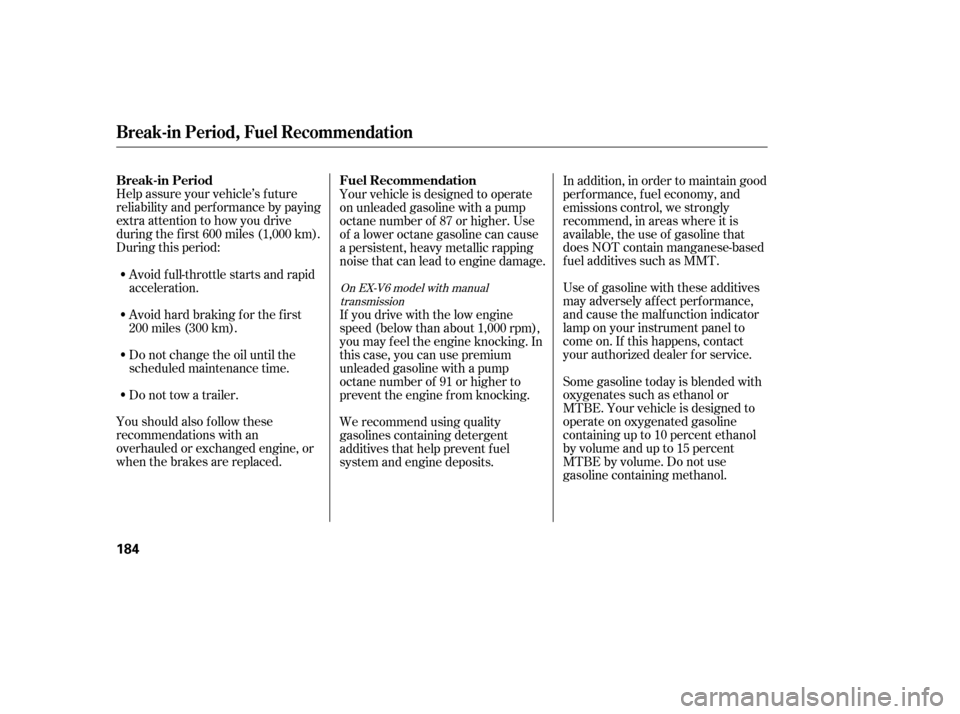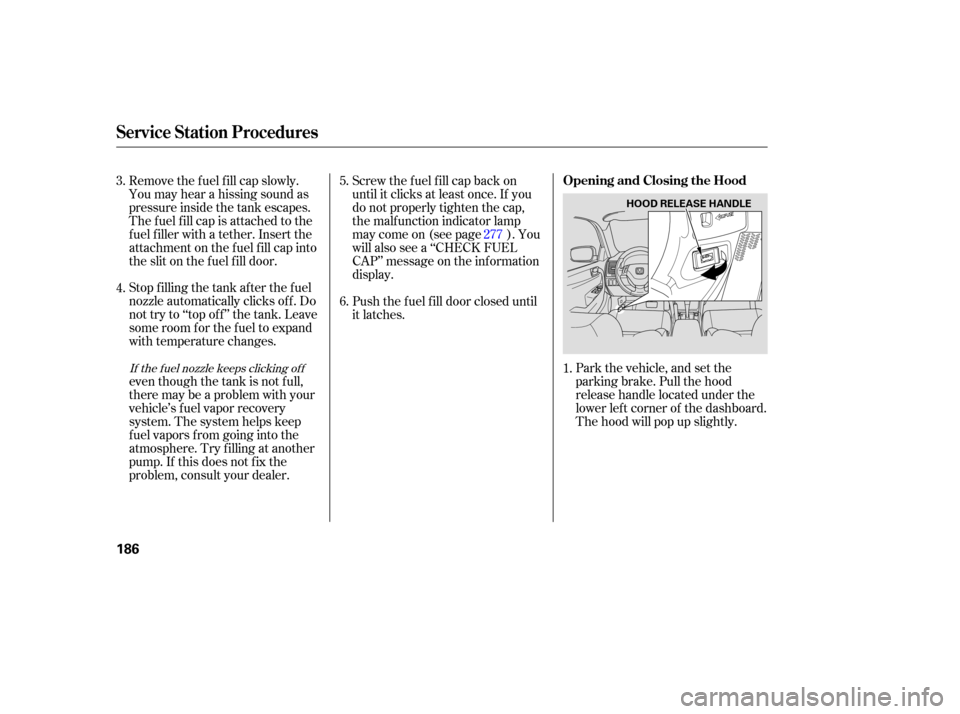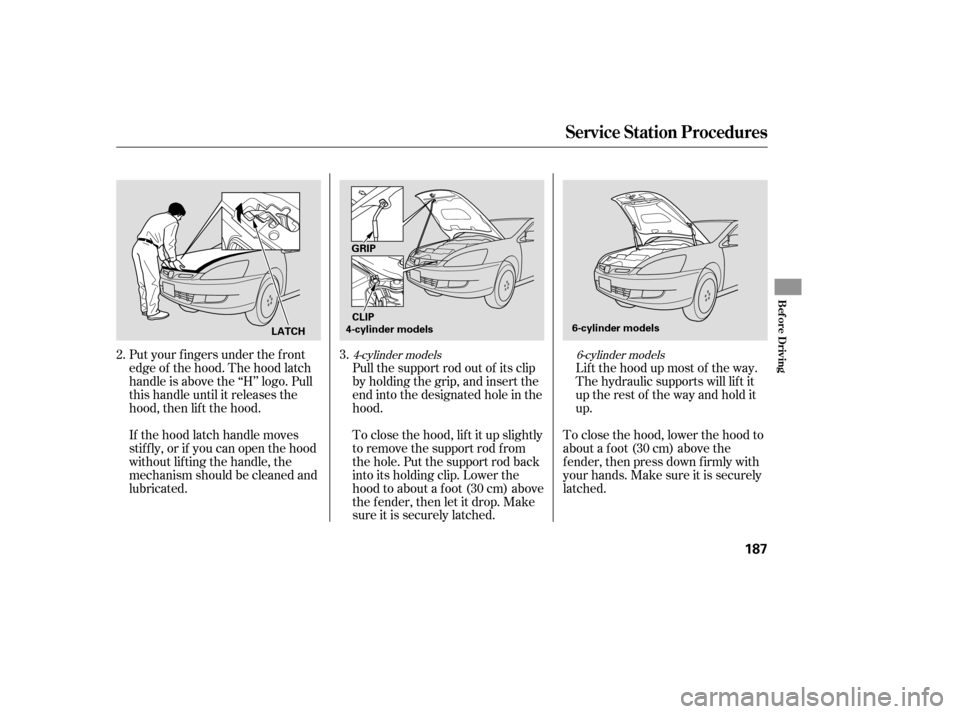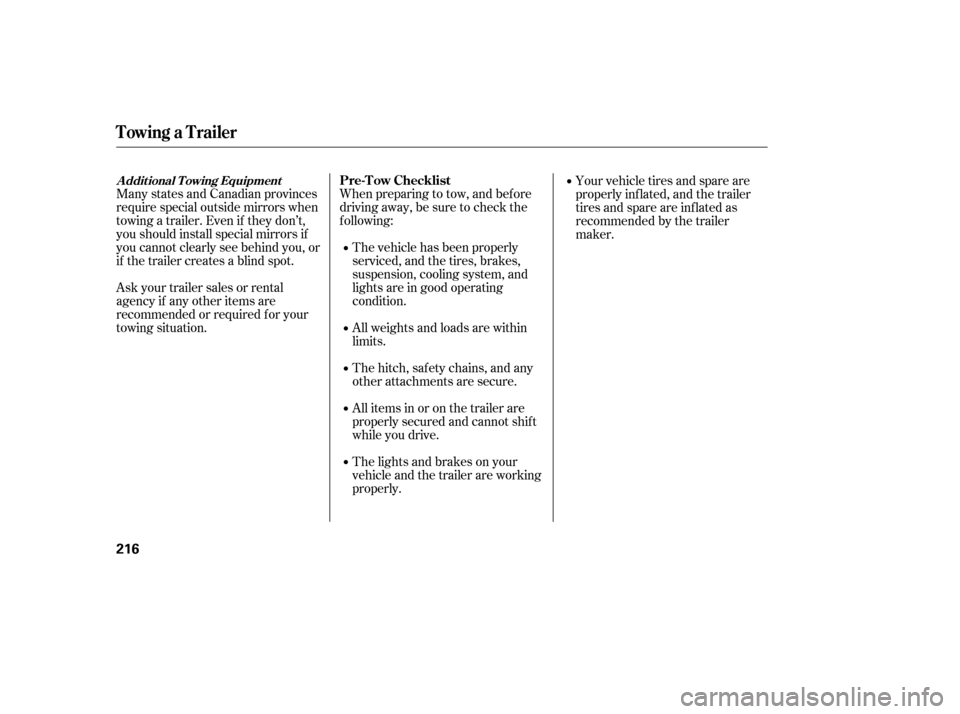Page 186 of 319

Help assure your vehicle’s f uture
reliability and perf ormance by paying
extra attention to how you drive
during the f irst 600 miles (1,000 km).
During this period:In addition, in order to maintain good
perf ormance, f uel economy, and
emissions control, we strongly
recommend, in areas where it is
available, the use of gasoline that
does NOT contain manganese-based
f uel additives such as MMT.
Use of gasoline with these additives
may adversely af f ect perf ormance,
and cause the malfunction indicator
lamp on your instrument panel to
come on. If this happens, contact
your authorized dealer f or service.
Avoid full-throttle starts and rapid
acceleration.
You should also f ollow these
recommendations with an
overhauled or exchanged engine, or
when the brakes are replaced. Your vehicle is designed to operate
on unleaded gasoline with a pump
octane number of 87 or higher. Use
of a lower octane gasoline can cause
a persistent, heavy metallic rapping
noise that can lead to engine damage.
Some gasoline today is blended with
oxygenates such as ethanol or
MTBE. Your vehicle is designed to
operate on oxygenated gasoline
containing up to 10 percent ethanol
by volume and up to 15 percent
MTBE by volume. Do not use
gasoline containing methanol.
We recommend using quality
gasolines containing detergent
additives that help prevent fuel
system and engine deposits. If you drive with the low engine
speed (below than about 1,000 rpm),
you may f eel the engine knocking. In
this case, you can use premium
unleaded gasoline with a pump
octane number of 91 or higher to
prevent the engine f rom knocking.
Avoidhardbrakingforthefirst
200 miles (300 km).
Do not tow a trailer. Do not change the oil until the
scheduled maintenance time.
On EX-V6 model with manual
transmission
Break-in Period Fuel Recommendation
Break-in Period, Fuel Recommendation
184
�����—�����—�����y�
���������
���y���
�(���%�������y���
�����y
Page 187 of 319
CONT INUED
Open the f uel f ill door by pushing
onthehandletotheleftof the
driver’s seat.
If you notice any undesirable
operating symptoms, try another
service station or switch to another
brand of gasoline.
For f urther important f uel-related
inf ormation, please ref er to your
.
Park with the driver’s side closest
to the service station pump.
1.
2. Ref ueling
Quick Start Guide
Fuel Recommendation, Service Station Procedures
Bef ore Driving
185
FUEL FILL CAP TETHER
Push
ATTACHMENT
Gasoline is highly flammable
and explosive. You can be
burned or seriously injured
when handling fuel.Stop the engine, and keep
heat, sparks, and flame away.
Handle fuel only outdoors.
Wipe up spills immediately.
�����—�����—�����y�
�������������y���
�(���%�������y���
�����y
Page 188 of 319

Park the vehicle, and set the
parking brake. Pull the hood
release handle located under the
lower left corner of the dashboard.
The hood will pop up slightly.
Stop
filling the tank after the fuel
nozzle automatically clicks off. Do
not try to ‘‘top off’’ the tank. Leave
some room for the fuel to expand
with temperature changes.
even though the tank is not full,
there may be a problem with your
vehicle’s fuel vapor recovery
system. The system helps keep
fu el vapors from going into the
atmosphere. Try filling at another
pump. If this does not fix the
problem, consult your dealer.
Remove
the fuel fill cap slowly.
You may hear a hissing sound as
pressure inside the tank escapes.
The fuel fill cap is attached to the
fuel filler with a tether. Insert the
attachment on the fuel fill cap into
the slit on the fuel fill door.
Push the fuel fill door closed until
it latches.
Screw the f uel f ill cap back on
until it clicks at least once. If you
do not properly tighten the cap,
the malf unction indicator lamp
maycomeon(seepage ).You
will also see a ‘‘CHECK FUEL
CAP’’ message on the inf ormation
display.
5.
6.
1.
3.
4.
277If the f uel nozzle keeps clicking of f
Service Station Procedures
Opening and Closing the Hood
186
HOOD RELEASE HANDLE
�����—�����—�����y�
�������������y���
�(���%�������y���
�����y
Page 189 of 319

Lif t the hood up most of the way.
The hydraulic supports will lif t it
uptherestof thewayandholdit
up.
To close the hood, lif t it up slightly
to remove the support rod f rom
the hole. Put the support rod back
into its holding clip. Lower the
hood to about a f oot (30 cm) above
the fender, then let it drop. Make
sure it is securely latched. To close the hood, lower the hood to
about a f oot (30 cm) above the
f ender, then press down f irmly with
your hands. Make sure it is securely
latched.
Pull the support rod out of its clip
by holding the grip, and insert the
end into the designated hole in the
hood.
Put your f ingers under the f ront
edge of the hood. The hood latch
handle is above the ‘‘H’’ logo. Pull
this handle until it releases the
hood, then lif t the hood.
If the hood latch handle moves
stif f ly, or if you can open the hood
without lifting the handle, the
mechanism should be cleaned and
lubricated. 3.
2.
6-cylinder models
4-cylinder models
Service Station Procedures
Bef ore Driving
187
GRIP
CLIP
4-cylinder models 6-cylinder models
LATCH
�����—�����—�����y�
�������������y���
�(���%�������y���
�����y
Page 190 of 319
Wait a few minutes after turning the
engine off before you check the oil.
Remove the dipstick (orange
handle/loop). Wipe
off the dipstick with a clean
cloth or paper towel.
Insert it all the way back in its hole. Remove
the dipstick again, and
check the level. It should be
between the upper and lower
marks.
If it is near or below the lower mark,
see on page .
1. 2.
3.4.
232
Service Station Procedures
Oil Check
A dding Engine Oil
188
DIPSTICK
(Orange Handle)DIPSTICK
(Orange Loop)UPPER MARK
LOWER MARK
4-cylinder models 6-cylinder models 4-cylinder models
�����—�����—�����y�
�������������y���
�(���%�������y���
���
�y
Page 191 of 319
Refer to
on page for information
about checking other items on your
vehicle.
Look
at the coolant level in the
radiator reserve tank. Make sure it is
between the MAX and MIN lines. If
it is below the MIN line, see
on page .
236 226
Service Station Procedures
Engine Coolant Check
Owner’s Maintenance
Checks
A dding
Engine Coolant
Bef ore Driving
189
UPPER MARK
LOWER MARK RESERVE TANK
4-cylinder models MIN MAX MAX
RESERVE TANK
6-cylinder models MIN
6-cylinder models
�����—�����—�����y�
�������������y���
�(���%�������y���
�����y
Page 218 of 319

Many states and Canadian provinces
require special outside mirrors when
towing a trailer. Even if they don’t,
you should install special mirrors if
you cannot clearly see behind you, or
if the trailer creates a blind spot.
Askyourtrailersalesorrental
agency if any other items are
recommended or required f or your
towing situation.When preparing to tow, and bef ore
driving away, be sure to check the
f ollowing:
The vehicle has been properly
serviced, and the tires, brakes,
suspension, cooling system, and
lights are in good operating
condition.
All weights and loads are within
limits.
Thehitch,safetychains,andany
other attachments are secure.
All items in or on the trailer are
properly secured and cannot shif t
while you drive.
The lights and brakes on your
vehicle and the trailer are working
properly. Your vehicle tires and spare are
properly inf lated, and the trailer
tires and spare are inflated as
recommended by the trailer
maker.
A ddit ional T owing EquipmentPre-T ow Checklist
Towing a Trailer
216
�����—�����—�����y�
������
������y���
�(���%�������y�����
���y
Page 221 of 319

This section explains why it is
important to keep your vehicle well
maintained and how to follow basic
maintenance safety precautions.
If you have the skills and tools to
perform more complex maintenance
tasks on your vehicle, you may want
to purchase the service manual. See
page for information on how to
obtain a copy, or see your dealer. This section also includes
instructions on how to read the
maintenance messages in the
inf ormation display, a maintenance
record, and instructions f or simple
maintenance tasks you may want to
take care of yourself . ......................
Maintenance Saf ety .220
....................
Maintenance Minder .221
....................
Maintenance Record .228
..............................
Fluid Locations .230
........................
Adding Engine Oil .232
.........
Changing the Oil and Filter .233
..............................
Engine Coolant .236
....................
Windshield Washers .238
.......................
Transmission Fluid .239
..........
Automatic Transmission .239
..............
Manual Transmission .242
................
Brake and Clutch Fluid .243
....................
Power Steering Fluid .245
....................................
Timing Belt .246
.............................................
Lights .246
................
Cleaning the Seat Belts .251
.....................................
Floor Mats .251
..................
Dust and Pollen Filter .252
.................................
Wiper Blades .252
...............................................
Tires .254
...................
Checking the Battery .260
.............................
Vehicle Storage .262
305
Maintenance
Maint enance
219
�����—�����—�����y�
�������������y���
�(���%�������y���������y